
views
Making Changes in Your Community

Learn more about the people in your community. Having a good understanding of your community will help you identify the best approaches for reducing racism. Read through your local newspaper, magazine, or websites to get some background information. What groups of people live in your community? Do these groups live and work together? Are neighborhoods segregated? Have there been any incidents of racism between different groups?

Welcome any newcomers to your neighborhood. Make your neighborhood an inviting place for any people of color or minorities that move into the area. Introduce yourself and tell them a little bit about the area so they feel welcome. For instance, you can tell them where the best local restaurants are or invite them over for dinner sometime. You could also go to a newcomer’s home with a gift like a fruit basket or a home-cooked meal so you can introduce yourself and welcome them to the neighborhood.

Speak up if you see racism in action. If you hear someone use racial slurs, make a racially insensitive joke, or mistreat people because of their race, step in and say something. You might be afraid of someone who is openly hostile, but think about how the other person feels. If you are afraid for your or the other person's safety, feel free to get an authority figure, such as the police, or an adult if you are a child or teenager. For example, if someone says "All _____ are criminals," ask the person, "Why do you say that?" or "Where do those beliefs come from?" Try saying, "That was an inappropriate thing to say." or "How would you feel if someone said something like that about you?" Address the behavior or the comment instead of the person. Don’t resort to name-calling or tell someone, "You're a racist." This will only offend them and make them angry.

Cultivate cross-race friendships with people around you. Make an effort to talk to people of other ethnicities and races who live or work around you. If you get along with someone, try organizing a get-together or a night out so you can get to know them and foster a healthy friendship. At the same time, it’s important that you respect someone’s space. Don’t be too pushy or force your friendship onto someone. For example, you could grab a cup of coffee with a neighbor or just spend a few minutes chatting with them whenever you run into them.
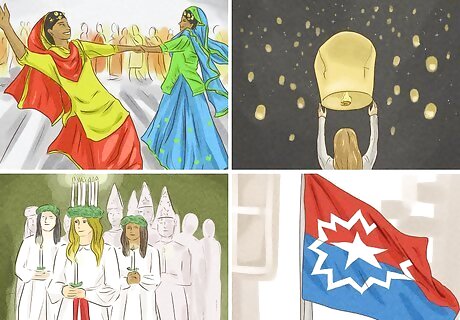
Attend local events that celebrate different cultures. Most cities have festivals and events celebrating different cultures and heritages. These events are a great place to learn about different cultures and interact with people from that culture. Invite your friends and family to go with you as well. Experiencing and celebrating other cultures is a great way to promote positive attitudes towards them. Events are often held in accordance with larger celebrations such as Black History Month, Asian-Pacific Heritage American Month, or National Hispanic Heritage Month.

Identify and change racist or exclusionary policies in your area. If you come across a club, bar, restaurant, or group that excludes minorities or has racist policies, don’t tolerate it. Point out the racism and call for it to be changed. Be a voice for others and don’t wait for other people to identify a racist policy or attitude. For instance, if your local pool discourages people of color from joining, ask them to make an effort to make their facilities more inclusive.
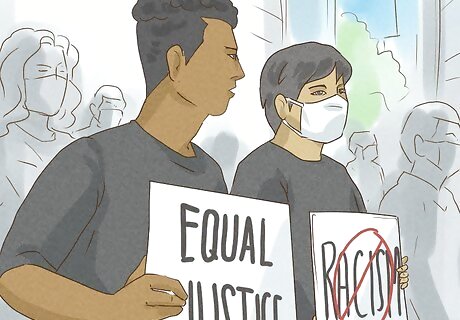
Organize a vigil or protest against racist incidents. Protests and demonstrations are powerful ways to combat racism in your community. If a racist event or incident takes place in your neighborhood or city, organize a protest against the injustice. If a hate group is coming to town or harassing people, create a petition to stop them. For example, if someone puts racial graffiti on a building, you could get together with some people to paint over the graffiti. Even if you are not able to organize something yourself, just the act of speaking up and introducing the idea is helpful. Start by contacting your friends, family, classmates, and neighbors.
Promoting Minority Rights
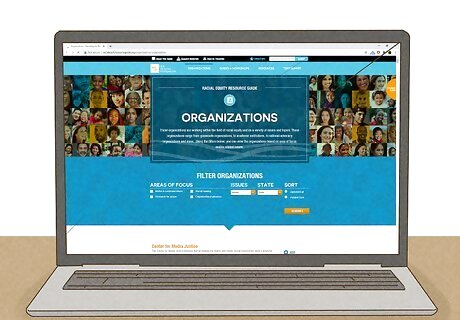
Join a group advocating for the rights of minorities. Find a local group dedicated to advocating for minority rights and fighting against racism. Volunteer your time to help the group or donate money to support their cause. Meet like-minded people and work to make changes in your community, country, and world. Get involved with a local, national, or international organizations. A few of the more well-known anti-racism groups include the International Committee Against Racism, Life After Hate, and United to End Racism.
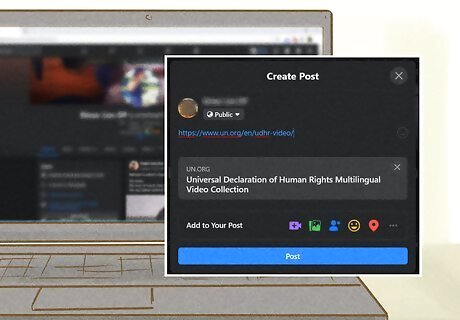
Share articles, videos, and information about human rights. Use your social media to post videos and articles that talk about human rights so other people can see them and learn more about them. Talk to your friends, family, and people that you meet about human rights and offer to share articles and videos with them. Visit the United Nations Universal Declaration of Human Rights Multilingual Video Collection at: https://www.un.org/en/udhr-video/.

Lobby and fight for nondiscriminatory laws. Racism happens at both the individual level and at the institutional level. Local and federal legislation can promote racism. Look for laws that promote equal salaries and equal opportunity. Petition your elected officials to support laws and policies that fight against discrimination. Write your elected officials, newspapers, or contact community organizers about the policies. You can write or call your elected officials to ask them to change discriminatory laws.
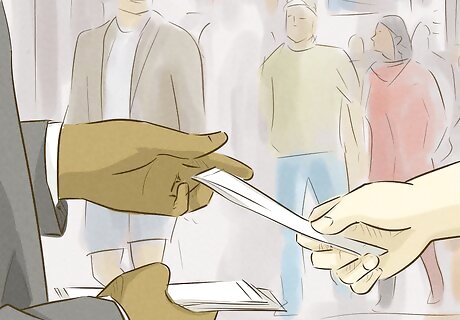
Support minority candidates running for local government. One of the best ways to enact legislative and policy changes is to have more races and ethnicities represented in local government. Find a minority candidate that you support, vote for them and get the word out about their campaign to help them get into office. You could volunteer for their campaign or make a donation to help support minority candidates.
Addressing Racism at School or in the Workplace

Talk to people of color at work about prejudices they face. Reach out to your coworkers or employees and ask them if they feel comfortable talking with you about the racism and prejudices that they face at work or in their profession. Use their experiences to make changes and put an end to discriminatory practices and behaviors. Don’t pressure anybody to talk to you about how they feel about racism that they’ve experienced. Respect their wishes if they don’t feel comfortable. For instance, if your coworkers tell you that they don’t celebrate certain holidays and they feel uncomfortable participating in festivities, don’t force them. If you have a coworker who tells you that a joke is offensive to them, stop telling it to make them feel more comfortable.

Identify racist policies that need to be changed. If your job or school has discriminatory policies, point them out. Acknowledge and bring attention to them. Ask them to be changed or change them yourself if you can. For example, if your school has a haircut policy that discriminates against someone’s culture or religion, try to change it to be more inclusive. If your job doesn’t recognize a specific holiday that’s important to someone’s culture, ask management to change their policy.
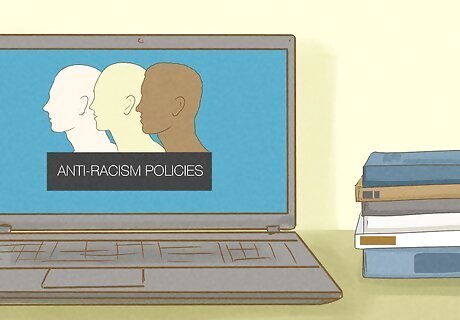
Include anti-racist education and policies. Anti-racist policies seek to actively oppose racism and promote tolerance and inclusion. Add more anti-racist policies and discussions to your classes or your workplace to help educate and make your environment more inclusive to minorities. An example of an anti-racist policy would be to promote or hire people of color as employees based more on their working experience rather than white employees based on their education or personal connections. EXPERT TIP Joseph Meyer Joseph Meyer Math Teacher Joseph Meyer is a High School Math Teacher based in Pittsburgh, Pennsylvania. He is an educator at City Charter High School, where he has been teaching for over 7 years. Joseph is also the founder of Sandbox Math, an online learning community dedicated to helping students succeed in Algebra. His site is set apart by its focus on fostering genuine comprehension through step-by-step understanding (instead of just getting the correct final answer), enabling learners to identify and overcome misunderstandings and confidently take on any test they face. He received his MA in Physics from Case Western Reserve University and his BA in Physics from Baldwin Wallace University. Joseph Meyer Joseph Meyer Math Teacher Support social justice practices in your school. Use data to explore social justice issues. Analyze who's enrolling in classes at school by factors like race and gender to identify potential inequalities. Discuss the implications of these findings with others and brainstorm solutions to promote equity.

Recruit and hire racially diverse people. Whether you’re in a school or an office, one of the best ways to help reduce racism is to hire a racially diverse staff. An inclusive and open learning or working environment that consists of multiple ethnicities can help promote understanding and tolerance.
Changing Your Personal Feelings about Race

Examine your own conscious and unconscious feelings. Every person has stereotypes and biases about people from other races. Think about what stereotypes you may have and ways you may be discriminating. Understanding your feelings can help you address them. For example, you may not realize that you have exaggerated beliefs, negative images, or distorted truths about a person or group. Take the Project Implicit Hidden Bias Tests at https://implicit.harvard.edu/implicit/. You may feel defensive or upset when you read your results. Just take a deep breath and remember that you can change your attitudes and beliefs. Think about the racism you have seen, experienced, or contributed to.

Write down your stereotypes and biases. Pick groups that you have generalizations about and write down your opinions about each of these groups. Be completely honest with yourself as you write. Once you have everything written down, write down where these ideas came from. Did they come from your parents? Did you have a personal experience? You may not even know where the ideas came from. Share your findings with someone from your same racial group if you feel comfortable, which can allow you to discuss your feelings without offending anyone else.

Educate yourself about racism. Read as much as you can about race relations, white privilege, and ways to reduce racism. Learn about the history of the culture and current happenings. Listen to other people talk about their experiences with racism. Examples of great books to read to better understand race include So You Want to Talk About Race by Ijeoma Oluo, Race and Racisms: A Critical Approach by Tanya Maria Golash-Boza, and Me and White Supremacy by Layla Saad. Talk to people within your racial group about your attitudes and beliefs before you have cross-cultural conversations. Look up conferences and alliances that allow you to work out your own feelings before you begin the work. Educating yourself is the best way to change your attitudes and beliefs.

Acknowledge differences among communities of color. People are grouped into large racial and ethnic groups such as White, Indian, Black, or Latino. But every group has internal differences and cultural variations. Ask people questions about where they grew up, what holidays they celebrate, or what kind of foods do they like to eat. For example, don’t assume that all Black people have the same culture. Black can include people from Jamaica, North Carolina, and Nigeria.

Read authors of other races to get different perspectives. Read novels written by authors that come from a different background and ethnicity than your own for insight into their experience. Diversify the stories you read to help inform yourself about the personal experiences of other people. Look online for recommendations of novels written by authors from other races. Additionally, watch TV shows and movies made and written by people of color to help inform your perspective as well.

Celebrate differences instead of being colorblind. It may seem like a good idea to pretend everyone is the same color, but you will miss out on how differences are natural and good. Value diversity instead of ignoring it. Race is often linked to cultural differences such as language, holidays, or clothing that influence how a person experiences the world. If you’re “colorblind,” you are not acknowledging these differences. Ignoring a person's race could be offensive to that person. They may feel like you are ignoring an important aspect of who they are.

Be kind to yourself as you learn more about racism. Every person has racist thoughts, and it’s actually a good thing that it bothers you. It will be uncomfortable to think about and talk about racism. But instead of being sad or feeling ashamed, put your energy into changing yourself and learning as much as you can.

















Comments
0 comment